#Eternal Gaming Rival! (Kris)
Explore tagged Tumblr posts
Text
The Chicago White Sox & The Cubs: A Tale of Two Baseball Legacies
Chicago is one of the few cities in America blessed with two Major League Baseball teams, each steeped in rich history and loyal fanbases. The Chicago White Sox and the Chicago Cubs represent two distinct traditions, cultures, and styles of baseball, yet they share a city where baseball is more than just a game — it’s a way of life. While both teams have had their ups and downs over the years, the rivalry between the North Side Cubs and the South Side White Sox remains one of the most compelling narratives in the sport.
In this blog, we’ll explore the history, triumphs, struggles, and legacies of the two iconic Chicago teams.
The Chicago Cubs: The Lovable Losers Turned Champions
Founded in 1876, the Chicago Cubs are one of the oldest baseball teams in Major League history. Originally known as the White Stockings before adopting the Cubs moniker in 1903, the team has played its home games at Wrigley Field since 1916, one of the most storied ballparks in the world. The ivy-covered outfield walls, manual scoreboard, and cozy neighborhood atmosphere make Wrigley Field a pilgrimage site for baseball purists.
For much of the 20th century, the Cubs were known as the “Lovable Losers,” enduring the longest championship drought in American sports history — 108 years. Despite boasting some of the greatest players in baseball history, including Ernie Banks, Ron Santo, and Billy Williams, the Cubs seemed cursed to fall short of winning a World Series, with heartbreaks such as the infamous 1969 collapse and the Steve Bartman incident in 2003 only adding to the legend of the “Curse of the Billy Goat.”
However, in 2016, the Cubs finally broke free from their past. Led by a talented roster including Kris Bryant, Anthony Rizzo, and the pitching ace Jon Lester, the Cubs won the World Series in dramatic fashion. Their Game 7 victory over the Cleveland Indians, which included an extra-innings thriller, ended the curse and united generations of Cubs fans in celebration. The parade that followed saw millions line the streets of Chicago, cementing the Cubs as not just “Lovable Losers” but eternal champions in the hearts of their fans.
The Chicago White Sox: A Legacy of Grit and Perseverance
The Chicago White Sox, founded in 1900, have a legacy deeply connected to the working-class spirit of the South Side of Chicago. With their black-and-white color scheme and gritty attitude, the White Sox have always been seen as the blue-collar counterpart to the more flashy Cubs of the North Side. They play their home games at Guaranteed Rate Field (originally Comiskey Park), a stadium known for its passionate fans and the towering, often hostile atmosphere it creates for visiting teams.
The White Sox, like their crosstown rivals, also experienced long stretches of frustration. Their most infamous moment came in 1919 when several players conspired to fix the World Series in what became known as the Black Sox Scandal. The fallout from the scandal tarnished the team’s reputation for decades, leading to their own championship drought, which lasted 88 years.
However, the White Sox’s moment of redemption came in 2005. Under the leadership of manager Ozzie Guillén, the team boasted a powerful pitching staff, led by Mark Buehrle and closer Bobby Jenks, and a well-rounded lineup that included Paul Konerko, Jermaine Dye, and Scott Podsednik. The White Sox stormed through the playoffs and swept the Houston Astros in the World Series, bringing home the championship and erasing decades of heartache for South Side fans.
While the 2005 victory was a moment of glory, the White Sox have largely remained in a state of rebuilding since. However, with a young, dynamic roster including stars like Luis Robert, Tim Anderson, and Eloy Jiménez, there is hope that the White Sox will soon recapture their winning ways and build another championship-caliber team.
A Tale of Two Sides: North Side vs. South Side
One of the most fascinating aspects of Chicago baseball is the rivalry between the Cubs and the White Sox. Though the teams play in separate leagues (the Cubs in the National League and the White Sox in the American League), their proximity and the fiercely loyal fanbases create a unique intra-city rivalry that transcends the sport itself.
The annual Crosstown Classic, a series of interleague games between the Cubs and White Sox, is a highlight of the season for Chicagoans. Fans from both sides of the city come out in full force, making it a lively and often intense affair. The rivalry isn’t just about baseball — it’s a reflection of Chicago’s cultural and social divides. The North Side is often associated with affluence and a more casual, carefree fanbase, while the South Side takes pride in its working-class roots and the hard-nosed, passionate nature of its fans.
The Cubs and White Sox in the Modern Era
In recent years, both the Cubs and the White Sox have undergone periods of transformation. After their 2016 World Series win, the Cubs experienced a brief era of success, consistently making the playoffs and contending in the National League. However, as key players left or dealt with injuries, the team began to struggle, and by 2021, the Cubs had started a rebuild, trading away core players like Kris Bryant, Anthony Rizzo, and Javier Báez.
The White Sox, meanwhile, emerged as a young and exciting team with a bright future. In the early 2020s, the Sox became a playoff contender, led by a talented roster and a strong pitching staff. However, despite the promise of their roster, the White Sox have struggled to break through in the playoffs, falling short of the World Series in recent years. Yet, with a strong farm system and a renewed focus on winning, hopes remain high on the South Side that the team will soon add another championship to its history.
The Legacy of Chicago Baseball
Despite their differences, the Chicago Cubs and the Chicago White Sox share a deep bond with their city and their fans. Chicago baseball is a source of pride for the city, with both teams representing different but equally important aspects of the city’s identity. The Cubs, with their historic ballpark and lovable underdog story, and the White Sox, with their gritty, determined style of play, are two sides of the same Chicago coin.
Whether it’s the allure of Wrigley Field on a sunny afternoon or the excitement of a packed crowd at Guaranteed Rate Field, baseball in Chicago offers a unique experience for fans. The shared love of the game, the history, and the passion for their teams unite Chicagoans, even if they wear different colors.
As long as the White Sox and Cubs exist, so will their rivalry and the hope of bringing another World Series trophy back to the Windy City.
0 notes
Text
tag dump
#Challenger Approaching! (Promo)#Hitting the Pause Button (OOC)#Ready? Go! (IC:B)#Fun Fact! (Headcanon)#Verse: Canon#Verse: Undertale#Verse: Sonic#Verse: Monster Prom#Verse: Crossover#Come to Gaze Upon My Sprightly Visage? (Berdly)#Eternal Gaming Rival! (Kris)#The Real Smart Kid (Noelle)#Not Only Kind but a True Gamer as Well (Susie)#Fun Gang Lackey (Ralsei)#Uh. Who is That Guy? (Lancer)#Put on a Pedestal (Self Promo)#Verse: Breath of the Wild#Natural Determination (IC:U)#Captain of the Royal Guard (Undyne)#Verse: Deltarune#Verse: No Mercy#Verse: Pacifist#Alphys' Showstopper (Mettaton)#Brains to the Brawn (Alphys)#Spaghetti Assistant (Papyrus)#Pumped to Get His Ass Kicked (Asgore)#Queen of the Ruins (Toriel)#Lazybones (Sans)
2 notes
·
View notes
Text
Deltarune/Brandish similarities
!!OBVIOUS SPOILERS FOR UNDERTALE/DELTARUNE AND THE BRANDISH SERIES!!
Making this post because HOT DAMN there are a lot of similarities when you look at them side by side.
But why Brandish? Because 1. It’s mentioned in the UNDERTALE artbook that Toby was inspired by Brandish about the whole ‘falling into a hole and going underground business’. There are also other parallels here, such as the first area of the game being named the Ruins (that’s the only thing specific to UT as far as I’m aware). And 2. The protagonist of Radiation’s Earthbound Halloween hack is Varik, which is the localized name of Ares, who is from Brandish.
Other than pointing at the stuff that inspired UT/DR’s creation, this post also serves as potential theoryfuel for whatever may occur in deltarune’s future. With that being said, let’s begin.
---
First, let’s get the obvious out of the way: Kris is based off Varik/Ares.

Both have a weird shadow above their face, use a sword and shield in-game, have a red-ish cloth thing around their neck, have exposed forearms and fell into a darker place along with some chick who wants to kick their ass. Another thing to note about the eyes is that, because of the game’s weird turning mechanic, we never see Ares/Varik’s face in-game, even in cutscenes. But Kris is, albeit rarely, sometimes portrayed with their eyes, right? Well, those eyes are red, same as Dark Ares’ eye color. (sidenote: Dark Ares uses ice magic in one of his attacks...) Another interesting tidbit is that Ares/Varik is sometimes portrayed with brown hair in official content and cutscenes, or blue hair in-game. Both hair colors were incorporated in Kris’ light world and dark world designs, respectively.
But wait, there’s more! Even beyond physical similarities, the few personality traits that Ares/Varik displays add up with Kris’ behavior. In the first Brandish game, at the end, there’s a choice to save your bounty hunter mage rival, Dela Denon/Alexis, or kill her. While you can choose whatever, in the later games, she’s still alive, so it can be argued that the option to save her is canon. Ares/Varik also saves her regardless of what you do in Brandish 2... So both Kris and Ares/Varik end up saving/defending the chick who wants to beat their ass in the end.
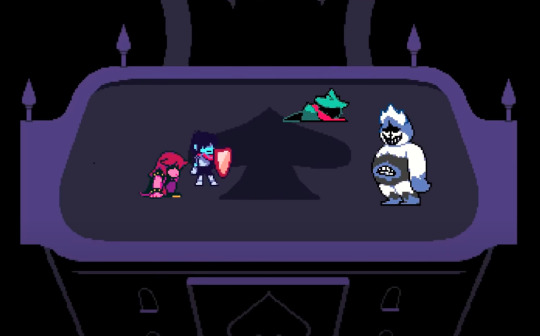

Another thing about these playable characters’ hidden personalities is the miniscule amount of trickery they engage in. It’s common knowledge at this point that Kris is a fan of pranks, but Ares/Varik also enjoys a good trick or two, as evidenced by his blink-and-you’ll-miss-it smile after giving Dela Denon/Alexis a broken sword instead of the Planet Buster.
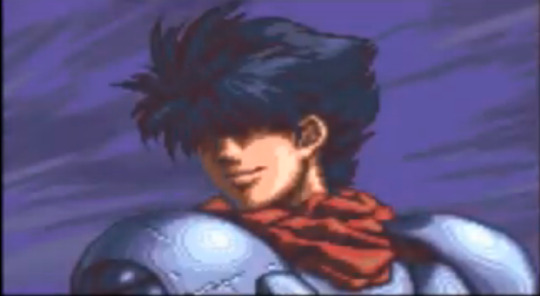
Besides that are even more similarities in other parts of the games. For starters, both games start with a cutscene about the darker world. There’s also this.
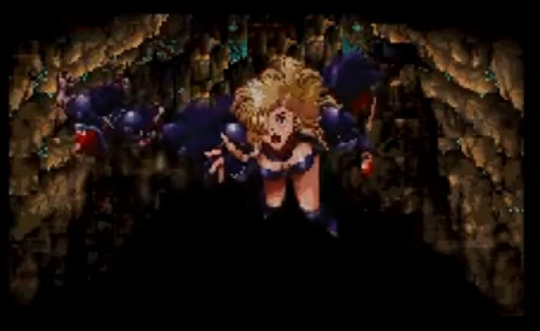

About that cutscene, by the by, there are two interesting tidbits from Brandish’s cutscene that were pretty obviously a source of inspiration for some of deltarune’s plot points.
In the center of the kingdom, piercing the sky itself,
stood a tall, majestic tower which symbolized this land.
I don’t think I need to explain what this inspired.
Doomed to an eternity of darkness…
Same as before. In that cutscene, there’s also a heavy focus on ‘the’ titles. The Protector, the Dragon, the King, a similar pattern to the Knight. In Brandish, the eyes of the King and army are also obscured similar to the heroes of prophecy in Deltarune’s opening cutscene, but the Dragon’s eyes are exposed. The only other exposed eyes in a stylized cutscene like that in Deltarune are the Titans.
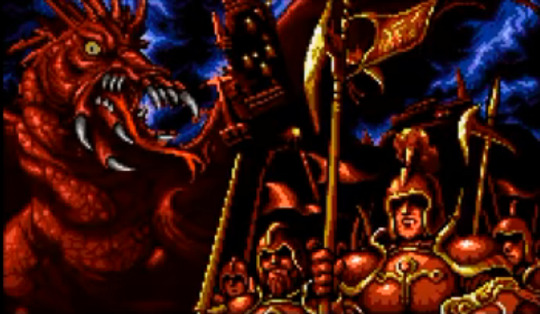


From Brandish 2: The Planet Buster, after Bundevia falls (i think)
So Bundevia shares Vittovia’s fate…
You sure bring calamity wherever you go.
That last line is very interesting, since it’s reminiscent of how every fountain the deltawarriors visit is eventually sealed, excluding the grand fountain. (Speculation Warning) I wonder if future chapters will touch on the morality of opening a fountain, beyond how it can end the world, since you’ll have to seal the fountain eventually and the way you got to that point will be kinda messed up either way. You’re taking many Darkners from their homes to castle town while separating them from their friends who chose to stay if you decide to recruit anyone, or you’re beating everyone up so you can sever the connection between that dark world and the light world/destroy their home. Toby has a record of utilizing game mechanics that one might not expect to matter too much. We already saw how Undertale deconstructed many RPG tropes, but it’s also noticeable in Toby’s earlier works like the Halloween hack, where you have to press the B button to continue, and where running away from the desperate survivors is treated as the ethically better choice. (even though there’s nothing that really highlights that as an option)
Wait, so you’re King Bedorrer? But you’re just a feeble old man!
In this scene before fighting God Bedorrer, Dela Denon/Alexis underestimates him by calling him a ‘feeble old man’ and later says:
You sure talk the talk, but to me you’re just a shut-in hermit living in a smelly old cave!
The King later calls her a strumpet, turns into a monster and fucks her shit up. But anyways, this may or may not be a possible clue as to who deltarune’s final boss may be: someone who we/the characters might not expect? But speaking of turning into a monsters, both King Bedorrer and King Berebus turn into a beast, Berebus, less willingly.
Berebus, unable to control the Dragon’s furry-filled power, was cursed. It
transformed him into a wretched beast… one that matched his evil nature.
Possibly a hint for the Titan Ralsei theory??
Misc.: Both games have a sound test room and dimensional boxes. And I can’t believe I got this far without mentioning the shop screen similarities.
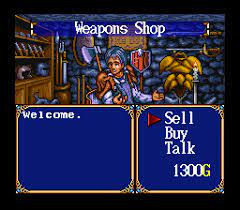
(accidentally added the Seam pic at the beginning, would’ve made for an interesting introduction lol)

Lastly, there are some fascinating pieces of dialogue in Brandish that I wanted to highlight.
The labyrinth layout is so complicated that when you tried to examine it closely, you got dizzy and decided not to look at it anymore.
Inspiration for the description of Ralsei’s manual?
That town, the rocks, this whole world is just an illusion. This place is nothing more than a nightmare. You’re in it, and so am I. There’s no way out. See look at this. My feet have turned to stone.
We all saw what happened to Rouxls Kaard and Lancer in Chapter 2.
“How many seasons have passed since this, our land, was swallowed by the earth? There is no one left that can answer that now. Our beloved land, along with the cursed King, will spend eternity forever in darkness. We wait. We wait for the one that will free us, free us from our cursed fate…”
Seems important, doesn’t it? [SOURCE]
---
If you got this far, thanks for reading! Feel free to add anything I missed or even got wrong.
#deltarune#deltarune speculation#deltarune theory#brandish#falcom#varik#ares toraernos#dela denon#kris deltarune#kris dreemurr#ralsei#susie deltarune
304 notes
·
View notes